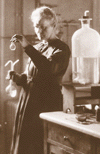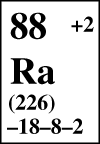Marie Sklodowska-Curie
by Agnes Muszynska
Maria Curie Skłodowska in her laboratory
 |
 |
This time we shall slightly divert from the mainstream of rotating machinery dynamics. This year marks a special anniversary, very dear to my native homeland, Poland : 100 years have passed since the discovery of two radioactive elements, polonium and radium. This discovery was made by two great scientists, Marie Sklodowska and her French husband, Pierre Curie.
Born in Warsaw , Poland , in 1867, Marie Sklodowska graduated with honors from high school in 1883. Poland was at that time under foreign occupation, and Marie was not allowed to enter the University of Warsaw . During the next few years she studied Sciences in the Polish underground “ Flying University ,” then in 1891 she went to Paris to continue her advanced studies at the Sorbonne. Soon she got involved in research, together with her husband, Pierre Curie, whom she married in 1893. In 1896 Marie published her first scientific paper. She investigated strange rays coming from uranium. She found that the amount of radiation depended on the amount of pure uranium in the ore sample, and she discovered that thorium compounds emit similar rays to uranium. Marie termed this effect “ radioactivity .” She also found that some ores gave out more radioactivity than could be explained by the presence of uranium and thorium. She realized that traces of a new radioactive element must exist in these ores. Together with Pierre , she found that radioactivity occurred in two chemically distinct parts of the pitchblende ore, showing that there were two new radioactive elements to be found. Marie named one of them polonium after her native land. The other, even more radioactive, she called radium.
Working hard in primitive and hazardous conditions, in a poorly heated wooden shed with a leaky roof, Marie and Pierre began to boil down tons of pitchblende ore to extract usable amounts of the new elements. While polonium happened to be very unstable and they failed to extract it, the Curie's hard labor resulted, in 1902, in 0.1g of radium chloride from over a ton of the ore. This amount was sufficient for them to determine radium's chemical characteristics. The next year, the Curies' discoveries were highly recognized: they received the prestigious Nobel Prize in Physics.
After the tragic death of Pierre Curie in 1906, Marie, who received her Ph.D. in 1903, was appointed to Pierre 's professorship at the Sorbonne. She became the first woman university professor. The fruitful continuation of her research on radium processing and analysis was crowned in 1911 with a second Nobel Prize, this time in Chemistry. Marie Sklodowska-Curie soon became a member of the prestigious Solvaya Physics Council, which included such famous scientists as Rutherford, Bohr, Einstein, and other creators of modern physics. Later on she also became a member of the Intellectual Cooperation Committee of the League of Nations.
Marie Sklodowska-Curie early recognized the therapeutic features of radium and its broad possibilities in treating cancers. As a result of scientific links between the Sorbonne and the Pasteur Institute, the new Radium Institute was created in Paris in 1912, where Marie worked until her death in 1934. She died from leukemia, as a victim of her scientific dedication.
The Curies were very unselfish. They published their results openly, with no attempt to patent their process or profit from it in any way, working only in the interest of science. The continuous struggle for funds to conduct research forced Marie to address the public to raise funds. In 1921, when Baron Henri de Rothschild created the Curie Foundation, Marie came to the United States to raise funds for the Radium Institute. She lectured at numerous universities. At the end of her stay, President Harding extended the hospitality of the White House to her, and gave her a gift from the American heart: 1g of radium. In 1929, Marie came back to the United States to raise funds for buying radium for the Warsaw Radium Institute, which she originated in 1919. Her mission was very successful again, and at that time, President Hoover gave her the American gift. In 1932 she carried it to Poland for the Grand Opening celebration of the Radium Institute in Warsaw. This Institute still exists today.
According to Susan Quinn, the author of the Sklodowska-Curie biography, the Curies originally worked at the margin of the official scientific establishment. They were outsiders, which allowed them to be independent intellectually. This led to discoveries that revolutionized the knowledge on the structure of the atom and its behavior.
Marie Sklodowska-Curie became one of the most popular women and role models in the world. The anniversary of the radioactivity discovery became the occasion of numerous commemorative celebrations, especially in France and Poland. One of the most important among them (originated by President Mitterand in 1995) was the transfer of Marie and Pierre Curie remains to the Pantheon in Paris, to lay there among the most famous and meritorious. Marie was the first woman to be so honored.
Reference
Quinn, Susan, "Marie Curie: A Life" (Radcliffe Biography Series), Addison-Wesley Publishing Co., May 1996, ISBN: 0201887940.